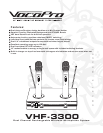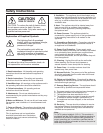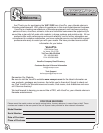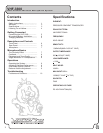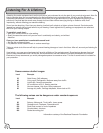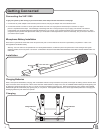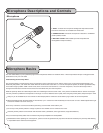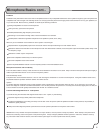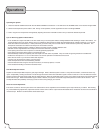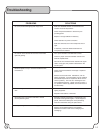
8
Microphone Basics cont...
Feedback
Feedback is the phenomenon that occurs when an amplified sound from any loudspeaker reenters the sound system through any open microphone and
is amplified over and over again. The resulting sound is an annoying howl that (when loud enough) poses a serious threat to not only your speakers, but
to your ears as well. Most commonly, feedback is caused by the following conditions:
Placing loudspeakers too close to the microphones.
Having too many open active microphones.
Overemphasis/boosting high-frequency tone controls.
Performing in environments with high ratios of hard and reflective room surfaces.
Overemphasis of effects that generate multiple harmonic repetitions (reverb, echo, delay)
What can you do if feedback occurs before the sound system is loud enough?
Request that the singer/speaker project their voice louder into the microphone allowing for a lower master volume.
Reduce the distance from the talker to the microphone. Each time this distance is halved, the sound system output will increase by 6dB, mainly in the
low-frequency range.
Reduce the number of open microphones.
Move the loudspeaker farther away from the microphone.
Move the loudspeaker closer to the listener.
Use an equalizer/feedback reducer to cut the frequency bands in which the feedback occurs.
Microphone Placement and Tone Quality
The VHF-3300 is ideal for close-up vocals and the mic can be handheld or mounted in a mic stand. Keep in mind that microphone technique is largely a
matter of personal taste--there is no one "correct" microphone position.
Lead and Backup Vocals
The performer's mouth should be less than 3” from or even touching the windscreen on an axis to the microphone. Doing this creates a robust sound,
emphasizes bass and provides maximum isolation from other sources
Speech
For spoken segments in between songs or public speaking types of applications of the VHF-3300, place the mic 4” to 10” away from your mouth, just
above nose height for a natural sound with reduced bass. You can also place the microphone 8” to 16” away from the mouth, slightly off to one side, for
a more “ambient” sound with greatly reduced bass and minimal “S” or sibilance sounds.
The VHF-3300 & Stage Monitor/P.A.. Loudspeakers
If you will be using the VHF-3300 with stage monitors and/or a P.A.. system, try the following:
Place the stage monitor(s) directly behind the microphones.
Locate the loudspeakers so that they point away from the rear of the microphone. (With the speakers located in these positions, the possibility of
feedback is greatly reduced).
Always check the stage setup before a performance to ensure optimum placement of microphone and monitors.
IMPORTANT: Every wireless microphone installation is a unique situation, and can present a variety of problems. Never attempt a live performance
without first conducting a test of the system in the performing area. If major changes (additional wireless systems or intercoms, relocation of set up,
etc.) have been made since the last test, check the wireless system again--as close to performance time as possible.



